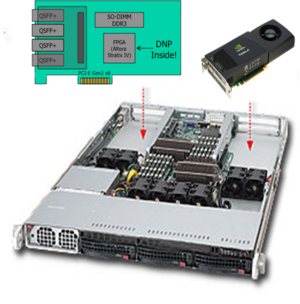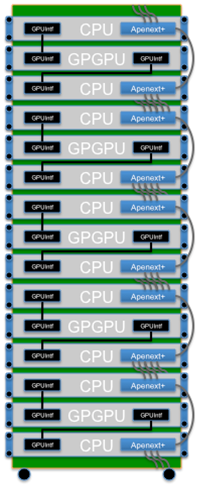Difference between revisions of "QUonG initiative"
| Line 15: | Line 15: | ||
=== The '''QUonG''' hardware === | === The '''QUonG''' hardware === | ||
| − | '''QUonG''' is a massively parallel computing platform built up | + | The '''QUonG''' system is a massively parallel computing platform built |
| − | commodity multi-core processors coupled with latest generation | + | up as a cluster of hybrid elementary computing nodes. Every node is made |
| − | + | of commodity Intel-based multi-core host processors, each coupled with a | |
| − | algorithms | + | number of latest generation NVIDIA GPU's, acting as floating point |
| − | where the computing nodes are topologically arranged as vertexes of a 3 | + | accelerators. |
| + | |||
| + | The '''QUonG''' communication mesh is built upon our proprietary | ||
| + | component: the [[APEnet+_project|APEnet+]] network card. Its design was | ||
| + | driven by the requirements of typical LQCD algorithms; this asked for a | ||
| + | point-to-point, high performance, low latency network where the | ||
| + | computing nodes are topologically arranged as vertexes of a 3 | ||
dimensional torus. | dimensional torus. | ||
| − | + | Our reference system is a cluster of '''QUonG elementary computing | |
| + | units''', each of which is a combination of multi-core CPU, GPU | ||
| + | accelerator and an [[APEnet+_project|APEnet+]] card. | ||
| + | This approach makes for a flexible and modular platform that can be | ||
| + | tailored to different application requirements by tuning the GPU vs. | ||
| + | CPU ratio per unit. | ||
[[File:Elemento_QUonG.png|border|right|300px]] | [[File:Elemento_QUonG.png|border|right|300px]] | ||
| + | |||
| + | === The '''QUonG''' Software Stack === | ||
| + | |||
| + | (in progress) | ||
=== The '''QUonG''' Prototype === | === The '''QUonG''' Prototype === | ||
| + | |||
The first prototype of the '''QUonG''' parallel system is expected to | The first prototype of the '''QUonG''' parallel system is expected to | ||
be delivered before the end of 2011. The chosen ratio for this first | be delivered before the end of 2011. The chosen ratio for this first | ||
deliverable is one (multi-core) host for two GPU's. | deliverable is one (multi-core) host for two GPU's. | ||
| − | As a consequence, the '''QUonG''' elementary mechanical assembly is a | + | As a consequence, the current target for the '''QUonG''' elementary |
| − | 3U "sandwich" made of two Intel-based servers plus a NVIDIA | + | mechanical assembly is a 3U "sandwich" made of two Intel-based |
| − | S2050/70/90 multiple GPU system equipped with the APEnet+ network | + | servers plus a NVIDIA S2050/70/90 multiple GPU system equipped with |
| − | board. | + | the [[APEnet+_project|APEnet+]] network board. |
The assembly collects two '''QUonG''' elementary computing units, each | The assembly collects two '''QUonG''' elementary computing units, each | ||
made of one server hosting the interface board to control 2 (out of 4) | made of one server hosting the interface board to control 2 (out of 4) | ||
| − | GPU's inside the S2050/70/90 and one APEnet+ board. In this way, a | + | GPU's inside the S2050/70/90 and one [[APEnet+_project|APEnet+]] |
| − | '''QUonG''' elementary computing unit is topologically equivalent to | + | board. In this way, a '''QUonG''' elementary computing unit is |
| − | two vertexes of the APEnet+ 3-dim mesh. | + | topologically equivalent to two vertexes of the |
| + | [[APEnet+_project|APEnet+]] 3-dim mesh. | ||
| Line 54: | Line 71: | ||
A typical '''QUonG''' PFlops scale installation, composed of 16 | A typical '''QUonG''' PFlops scale installation, composed of 16 | ||
| − | '''QUonG''' racks interconnected via APEnet+ 3-dim torus network, will | + | '''QUonG''' racks interconnected via [[APEnet+_project|APEnet+]] 3-dim |
| − | be characterized by an estimated power consumption of the order of 400 | + | torus network, will be characterized by an estimated power consumption |
| − | kW and a cost ratio of the order of 5 kEuro/TFlops. | + | of the order of 400 kW and a cost ratio of the order of 5 kEuro/TFlops. |
[[File:QUonG_rack.png|border|left]] | [[File:QUonG_rack.png|border|left]] | ||
Revision as of 11:39, 22 June 2011
The QUonG Proposal
The QUonG proposal is an initiative by ![]() INFN (Istituto Nazionale di Fisica Nucleare)
targeted at nurturing a hardware-software ecosystem centering on the
subject of Lattice QCD.
INFN (Istituto Nazionale di Fisica Nucleare)
targeted at nurturing a hardware-software ecosystem centering on the
subject of Lattice QCD.
Leveraging on the acquired know-how of the APE group in the co-development of High Performance Computing systems dedicated (but not limited) to LQCD, QUonG aims at providing the scientific community a comprehensive platform for the development of LQCD multi-node parallel applications.
The QUonG hardware
The QUonG system is a massively parallel computing platform built up as a cluster of hybrid elementary computing nodes. Every node is made of commodity Intel-based multi-core host processors, each coupled with a number of latest generation NVIDIA GPU's, acting as floating point accelerators.
The QUonG communication mesh is built upon our proprietary component: the APEnet+ network card. Its design was driven by the requirements of typical LQCD algorithms; this asked for a point-to-point, high performance, low latency network where the computing nodes are topologically arranged as vertexes of a 3 dimensional torus.
Our reference system is a cluster of QUonG elementary computing units, each of which is a combination of multi-core CPU, GPU accelerator and an APEnet+ card. This approach makes for a flexible and modular platform that can be tailored to different application requirements by tuning the GPU vs. CPU ratio per unit.
The QUonG Software Stack
(in progress)
The QUonG Prototype
The first prototype of the QUonG parallel system is expected to be delivered before the end of 2011. The chosen ratio for this first deliverable is one (multi-core) host for two GPU's.
As a consequence, the current target for the QUonG elementary mechanical assembly is a 3U "sandwich" made of two Intel-based servers plus a NVIDIA S2050/70/90 multiple GPU system equipped with the APEnet+ network board.
The assembly collects two QUonG elementary computing units, each made of one server hosting the interface board to control 2 (out of 4) GPU's inside the S2050/70/90 and one APEnet+ board. In this way, a QUonG elementary computing unit is topologically equivalent to two vertexes of the APEnet+ 3-dim mesh.
The envisioned QUonG Rack
Building from the configuration of the first QUonG prototype equipped with current NVIDIA Tesla GPU's with Fermi architecture, we envision a final shape for a deployed QUonG system as an assembly of fully populated standard 42U height QUonG racks, each one capable of 60 TFlops/rack in single precision (30 TFlops/rack in double precision) of peak performance, at a cost of 5kEuro/TFlops and for an estimated power consumption of 25 kW/rack.
A typical QUonG PFlops scale installation, composed of 16 QUonG racks interconnected via APEnet+ 3-dim torus network, will be characterized by an estimated power consumption of the order of 400 kW and a cost ratio of the order of 5 kEuro/TFlops.

